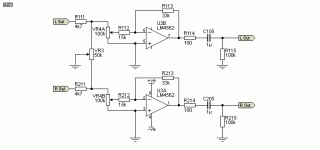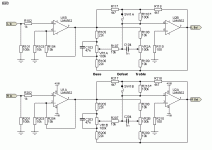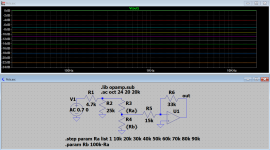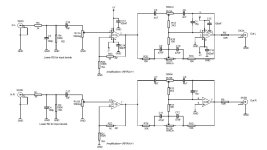I found S-taper only beneficial with very large control ranges like +-20dB or so, to de-compress the range ends. For more reasonable +-6dB max action, linear is good enough.In fact, for active tone or EQ controls, best curve is neither 😲 but so called "S curve", starting with Log, ending with anti-log.
Here are the two stages.What does that exactly mean?
Please show the schematic.
"The volume control uses a linear pot and a modified version of Project 01 'Better Volume Control' to obtain a log response."
Attachments
Alps RK271-series ("Blue Velvet") is available as a linear pot. Bourns has some nice options too.
Tom
Tom
Where did you see those? I bought four 50k linear RK271's on eBay from a guy in Germany about a year ago. He doesn't have any more. Those were the last ones I could find.Alps RK271-series ("Blue Velvet") is available as a linear pot. Bourns has some nice options too.
Thanks,Yep, I did the same thing on my last build.
The ESP preamp I'm currently building, however, is logarithmic using a linear pot.
Yes. It uses the heavily loaded linear pot principle, paralleling the wiper-to-ground section with a very low value resistor, between 1/6th and 1/10th of the pot value.
Not an easy load to drive to say it politely and it demands very low impedance drive or a buffer.
So quite a limited usefulness spectrum.
Notice the tone controls shown there use linear pots but those are NFB/active tone controls, that was cleared before.
Hmmm... I could swear I saw some at Mouser. P/N 688-27112A0F20C0V503 looks linear from the data sheet but is listed as a logarithmic pot. Go figure.Where did you see those?
There are are quite a few of the RK097 in stock at Mouser with linear taper. 688-RK097111TD2M is an example.
Bourns PTD902-10BAP-B203 (also in stock at Mouser) is one of the many linear Bourns options.
Tom
So 10k pot and 1k5 perhaps - presenting minimum load of 10k||1k5 = 1k3.It uses the heavily loaded linear pot principle, paralleling the wiper-to-ground section with a very low value resistor, between 1/6th and 1/10th of the pot value.
How is 1k3 difficult to drive? Or "very low impedance"? Am I misunderstanding the set up somehow?Not an easy load to drive to say it politely and it demands very low impedance drive or a buffer.
So quite a limited usefulness spectrum.
Look at the schematic, it's actually 100k loaded by 15k, and it's driven by the LM4562 in fig. 1.
The tone circuit could easily be scaled to accept the standard 10k lin pots without presenting a unduly load to the opamps.
The volume control is pretty meh IMHO, not up the the usual ESP standards.
Get a quality 10k log feeding a noninverting opamp stage and be done. The balance control (again with a much too large adjustment range IME) could be moved to the input stage gain.
If you really want to use a lin pot, build a Baxandall volume circuit, which gives you a balanced output for free.
The volume control is pretty meh IMHO, not up the the usual ESP standards.
Get a quality 10k log feeding a noninverting opamp stage and be done. The balance control (again with a much too large adjustment range IME) could be moved to the input stage gain.
If you really want to use a lin pot, build a Baxandall volume circuit, which gives you a balanced output for free.
An unwritten but quite practical rule of thumb is : "drive a pot (or a passive equalizer such as a James type tone control, a passive notch control, etc.) from 1/10th its own impedance, feed output into 10X its own impedance"So 10k pot and 1k5 perhaps - presenting minimum load of 10k||1k5 = 1k3.
Do we agree so far?
Much applied in "passive preamps", very popular here.
In ESP's preamp shown above the loading resistor is hidden in plain sight:
Volume control Vr4a is 100k, next stage impedance is 15k.
Because it is an inverting OpAmp
That "100k" volume control is being fed through a 4k7 resistor.
In a standard design , using a 100k Log pot, typically feeding a 220k to 1M next stage, the "rule of thumb" applies perfectly.
Drive always sees 100k, or to be more precise, when "on 10" it sees next stage impedance in parallel.
Since conventional wisdom expects, say, 200k to 1M there, no big deal .
Here it does NOT, quite the opposite:
* Those 4k7 feed a pot which varies in impedance, from 100k when "set to 1" to 13k when "on 10"
Gross.
Also: next stage gain varies a lot.
- pot set low: 33k/15k=2.2X
- Pot set halfway: 0.49X
Gross.
Of course, you can "solve" this poor design choice by throwing parts at it: add 2 Op Amps to drive that cheesy pot simulation, then another 2 after it to separate it from next stage.
Not my cup of tea, I always remember that funny but realistic definition:
"an Engineer is that guy who can do with $1 what any fool can do with $10"
In this case, using the proper part is actually cheaper/easier/simpler/smaller than using the cheesy kludge.
Yes.How is 1k3 difficult to drive? Or "very low impedance"? Am I misunderstanding the set up somehow?
A 100k pot is supremely easy to drive, can be put straight after any passive EQ network, including a tone control, can be driven from a transistor collector in the classic gain stage, even a tube plate resistor stretching things a bit, the works.
Otherwise you need an Op Amp or some kind of buffer to drive it.
Which I mentioned in my earlier post.
.
So do you have a better preamp design you could recommend? With tone controls that is.this poor design choice
Literally tons of good designs out there, including in this very Forum.
Browse and pick the one you prefer.
I am not pushing any specific design..
Browse and pick the one you prefer.
I am not pushing any specific design..
I don't really see the problem with this design. As I said above, that stage is in fact driven by a LM4562 from the previous stage shown in fig. 1., so no need to add any extra opamps, the 4k7 resistor is required for the balance control and in simulation the gain adjustment looks perfectly fine without buffering the pot, you get around -11 dB with the pot in the middle position and a smooth taper towards the extremes, see attached. What's wrong with that?
Attachments
1) I am not worried by this particular preamp which is just one example but of the generalized (and incorrect) idea that you can happily replace a Log pot by this kludge with no consequences.
The main problem.being the 6:1 to 10:1 pot impedance variation. Gross.
TONS of classic designs in the last 60 years where you can NOT just replace a true Log pot with a "simulated" one.
2) funny but you are confirming what I say 😎
"No need to add an Op Amp"?
Of course, you already used one 😄
How does that contradict me? 🤔
The main problem.being the 6:1 to 10:1 pot impedance variation. Gross.
TONS of classic designs in the last 60 years where you can NOT just replace a true Log pot with a "simulated" one.
2) funny but you are confirming what I say 😎
"No need to add an Op Amp"?
Of course, you already used one 😄
How does that contradict me? 🤔
Apologies, I misunderstood you. It did sound to me like you were criticizing this particular design.
I chose the ESP because I don't have the resources or expertise to make my own board. I tried a couple Chinese boards and they were indeed "gross."
This is a kit I found and they provide specs and a schematic. Would this pass the gross test? It comes with TL072's but I would use the LM4562's I already have.
This is a kit I found and they provide specs and a schematic. Would this pass the gross test? It comes with TL072's but I would use the LM4562's I already have.
Attachments
- Home
- Design & Build
- Parts
- Why are all the good pots log/audio taper?



